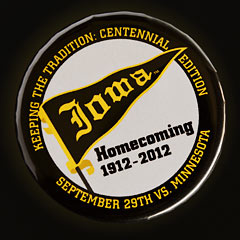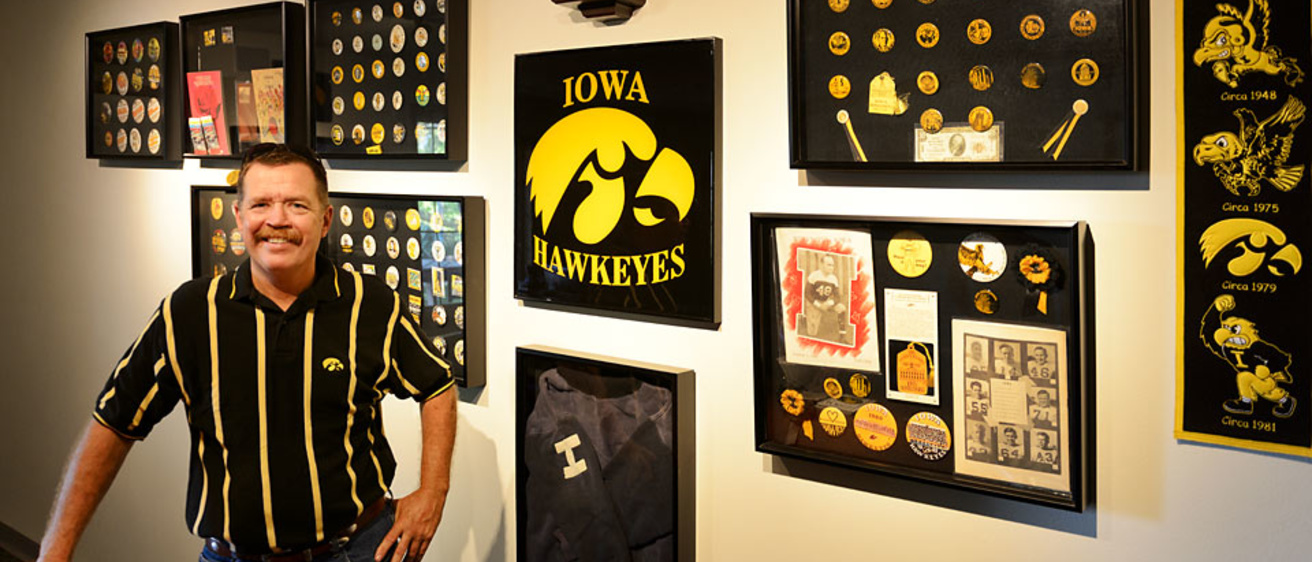Joel Miller has all 89 official University of Iowa Homecoming badges, none of which he has ever worn.
“After I buy one, I put it up right away,” says Miller (B.S. ’96), a rural Solon, Iowa, resident who inherited a set of Homecoming badges when his father, Larry Miller (B.A. ’48, M.D. ’51), passed away five years ago. He has added to the collection, and recently gave it a featured spot on the wall of his home shop, after carefully positioning the badges in even rows inside velvet-lined shadow boxes.
100 years of Homecoming
The first Homecoming at the University of Iowa was held on Nov. 23, 1912, and was marked by a football game against Wisconsin. Although the Hawkeyes lost that contest, a wonderful tradition for UI faculty, staff, students, alumni, and community members was born.
This fall the university celebrates the annual event’s 100th anniversary. The theme is “Keeping the Tradition: Centennial Edition.” For more details on the 2012 festivities, see homecoming.uiowa.edu.
To see a gallery of collectible Iowa badges, click here.
“When my father died, we found the Homecoming buttons rolled up in a towel at the bottom of a dresser drawer,” says Miller, director of facilities services at Cornell College.
Though both of his parents were UI graduates and interested in collectibles, it was his mother, Jonnye Chambers Miller (G.N. ’47), who started the badge collection. As the only one among his four siblings to graduate from Iowa, Joel Miller was only too happy to “continue the legacy.” Other Hawkeye memorabilia in his collection include yearbooks dating back to the 1920s, a leather-bound commencement program from 1912, and a UI game ball from the 1940s.
“I do it for the tradition,” he says. “I want to keep it going.”
For alumni and fans interested in accumulating Hawkeye memorabilia, collecting Homecoming badges is a common and easy place to start, says Herb Staub, longtime dealer of collectibles and author of several price guides on Iowa Homecoming badges.
“They don’t take up a lot of room, they have a date, there is information available about them, and their value goes up,” he says, noting that a passion for collectibles often is passed on between family members, as in Miller’s case.
“No one wakes up one morning and decides to collect Homecoming badges,” he adds. “Either they’ve been given one badge or a collection of badges, or else they’ve had a positive experience with the Hawkeyes and start accumulating items and then want to track down any missing pieces.”
Evolution of the Iowa Homecoming badge
Illustrations of Iowa’s beloved mascot, Herky, have been featured on a majority of designs, but other subjects have included Iowa coaches and players, campus buildings, the Hawkeye Marching Band, and even an ear of corn. For several decades, the only colors used were black and a shade of gold or yellow, then white became a common background starting in the 1950s. By 1971, Herky is clutching red roses, and by the late 1990s, full color debuts.
Although there is one official Homecoming button design each year—with the exception of 2002, when a smaller, student-oriented variation of that year’s design also was issued—characteristics of the badge have evolved over the years. The size has fluctuated, starting at under two inches in diameter in 1924 (the first year of officially recognized Homecoming badges) and expanding to three inches in recent decades and then settling back to two-and-a-quarter inches. The shape usually is round, though occasionally it’s been square, rectangle, or diamond.

“Design in recent years seems to have gotten away from the traditional Hawkeye black and gold,” says Staub. “In my opinion, a good design is one that is recognizable from three feet away. But now, with the aid of computers, you can get much more detailed, and sometimes you can’t even tell what it is. This year’s design, however, is more traditional.”
In fact, because of its clean and traditional design, the 1924 badge is Staub’s favorite. It reads, simply, “SUI Homecoming, Oct. 24, 1924” and shows a football player tackling another. His wife stumbled upon one such badge in a laundry chute at Mount Mercy College in 1969; the couple eventually traded it for a chest freezer and a color TV.
The Holy Grail for badge collectors, says Staub, is the one issued in 1943. To save metal during World War II, the badge was made from paper and had a gold tassel looped through the top. Some 10,000 were sold at 10 cents a piece, but it rained that day, and players later reported picking torn, muddy badges out of their cleats. Those still in existence can fetch $2,000 to $3,000.
Another coveted piece is a limited-edition Homecoming badge from 1982, a variation on that year’s “Catch-a-Cat” theme. To raise money for their squad, the Hawkeye cheerleaders designed and sold 100 badges for $10 each. The items sold out immediately and now are valued around $3,000. But, Staub notes, finding a collector willing to part with one is rare.
Buttons and T-shirts and toasters—oh, my!
In addition to the Homecoming badges, Joel Miller has peppered his collection with other Hawkeye items: buttons marking Iowa’s bowl game appearances, several team badges that were produced before 1924, a football program that lists his father (his dad played halfback in the 1940s), a pair of Rose Bowl drinking glasses from the 1980s, and more.
The success of Iowa’s football team under former coach Hayden Fry—drawing bids to the 1982 and 1986 Rose Bowls among many other postseason contests—helped explode the market for Hawkeye merchandise and memorabilia, says Dale Arens, director of Iowa’s licensing program and the UI Athletics Hall of Fame. That era also marked the infancy of collegiate licensing and lucrative broadcasting deals.
“The Homecoming button is steeped in tradition, but anything that commemorates or marks a specific date or event falls into the realm of collectibles. We started licensing steins for every bowl game Iowa went to, with the bowl game logo on one side and a summation of the season on the other, and people would line them up on their mantels,” he says. “ I know people who buy T-shirts and never intend to wear them.”
Apparel is the largest product category of officially licensed UI merchandise, Arens says, “but I don’t think there’s anything that hasn’t been thought of.” He manages contracts with more than 600 companies worldwide that have sought to market products using Hawkeye trademarks. Iowa fans are likely to find just about anything they desire emblazoned with the Hawkeye logo—from bobble heads to toasters to golf balls.
“Interest in Homecoming badges easily spills over to other Hawkeye items,” Staub says. “Most of the Hawkeye nuts I know have everything. It’s a thrill they can experience outside of the game.”
A pastime on the periphery?
Even with the proliferation of Hawkeye memorabilia, the hobby of collecting it seems to be taking a hit. This waning interest disappoints Staub, who will serve as grand marshal of the 2012 Iowa Homecoming parade.
“There have been a lot of changes in the past 30 years,” he says. “While there is a large number of enthusiastic collectors, that group is aging. You don’t see young people investing and chasing down items. I can tell by the number of requests I get.”
Children are spending their free time much differently than they did when he was young, Staub says. Cell phones and computers serve as a distraction, and a poor economy doesn’t help.
“People are drawn to collecting because it ties into the memories they have of growing up, but today’s generation is not the same,” he says. “Kids are not as likely to be out earning money to add to their collections of baseball cards or comic books. It’s a different world, and accumulating [collectibles] is not so much a part of it.”
To help build enthusiasm for Hawkeye collectibles, organizers of the annual FRY Fest celebration in Coralville, a group that includes both Staub and Arens, added the Hawkeye Collector’s Showcase to this year’s programming. As part of the Sept. 7 event, area collectors were invited to show off some of their most prized Hawkeye memorabilia, and Frank Fritz, star of the TV show American Pickers, stopped by to make a presentation and sign autographs.
Miller says his children are big Hawkeye fans, and he hopes to pass on his collection to one of them. In the meantime, there is one item he is longing to add.
“I really want a life-size, cardboard cutout of Hayden Fry,” he says. “Where can I get one?”
To see what kinds of Hawkeye products were available at this year's FRY Fest, check out this Spectator slide show.
